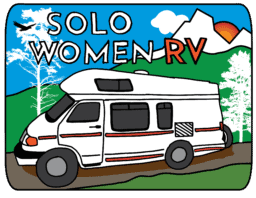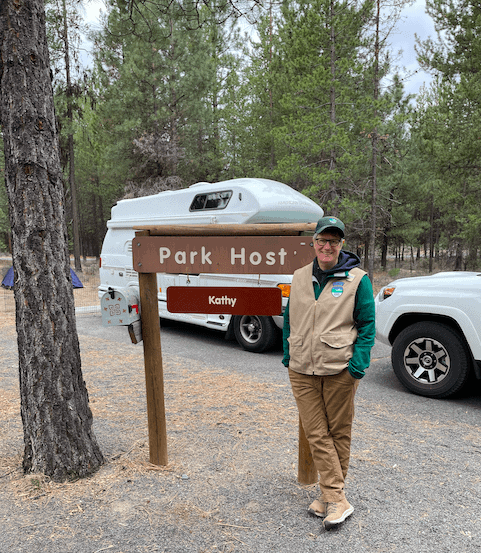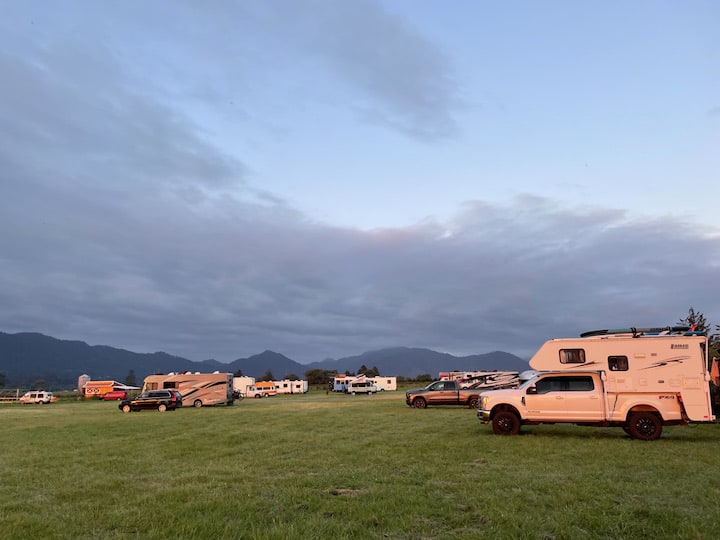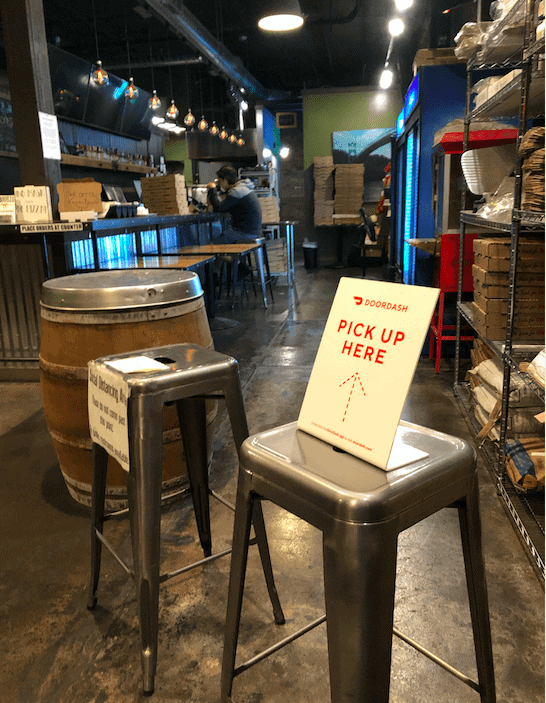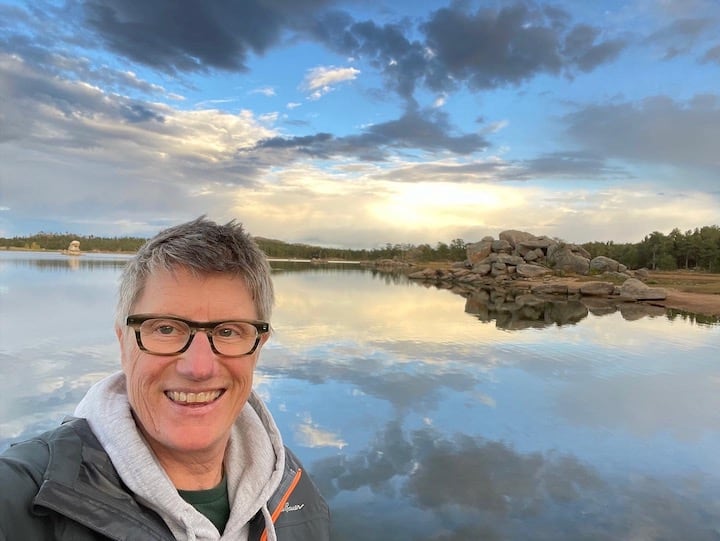Best RV Apps for Women
As a solo woman RVer, I rely on my camping apps to find me great places to camp, places to hike, sights to see and even places to get cheap gas. There are a lot of different campings apps out there. Some are free. Some cost money to use. Some are part of a paid membership. I’ve tried a lot of different apps over the years and these are the 11 favorite camping apps that I’ve kept on my phone and that I use the most on an almost daily basis.

What I look for in a Camping App
I’m on an iPhone, so I look for camping and travel apps that integrate well on my phone and are easy to use. (Note: All of these apps also have Android versions.) Since I am on the move, I like apps that use my location to suggest things that are in my area. I don’t like my apps to be crowded up with a lot of advertising, so I look for apps that allow me to get the information I need without a lot of clutter.
Here are the Top Camping Apps that I use in 2025:
1. My Favorite Camping App: The Dyrt Pro
A few years ago I won a free membership to The Dyrt Pro. Typically I don’t pay for apps, but after using the paid version for a couple of years, I really appreciate the value and extra benefits that come from the paid app.
The Dyrt is a wonderful camping app. It’s a woman-owned business and has a free and paid version. I’m a PRO member, which costs about $35 per year.
My two favorite features of the PRO membership vs the free one are the ability to search for free camping and the ability to plan trips. I can use the app–for when I’m on the go and want to find a spot near me–or I can use the website for trip planning, when I want to see a bigger screen.
PRO members also have access to offline maps, which has helped me with planning when I don’t have cell service. PRO members also are eligible for discounts at some RV parks. Since I don’t tend to stay in RV parks, I haven’t used this perk yet.
You can also set alerts for sold-out campgrounds, if you’re trying to get into a popular national park or nab a holiday weekend at a popular place near your home. I tried this feature at the campground I work at, just to see how it works and it was pretty spot on.
One feature the Dyrt has – in both the free and paid versions – that I haven’t seen in other apps is the ability to upload and view videos of campgrounds. This can give a different perspective than just looking at photos.
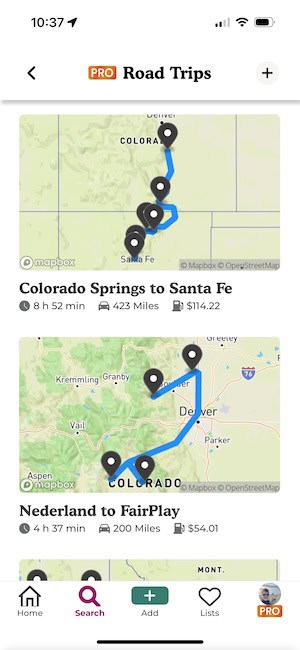
What I Love about The Dyrt Pro RV Camping app:
What I don’t Love about The Dyrt Pro RV App:
2. Harvest Hosts RV app
I am a big fan of Harvest Hosts. Harvest Hosts is a camping membership that allows you to stay at small businesses like wineries, family farms, brew pubs, museums, golf courses and so much more. Many time these spots are more scenic then any campground I’ve stayed in.
There are several membership levels and I have the one that includes Boondockers Welcome. Boondockers Welcome allows you to park overnight for free at people’s houses. Oftentimes, homeowners will offer hook-ups and and more than one night. This option has been great for me when I’m staying in or near a city.
New in 2024, a lot of Harvest Hosts locations now have the option to stay more than one night and some offer hook-ups. Both of these usually come with an added fee, but if you’re looking for this feature, it can be well worth it.
I’ve written before about this unique way to travel and I find myself looking every time I am moving to find if there is a place to stay along my route. Harvest Hosts is a membership organization that allows you to camp for free at farms, wineries, museums, golf courses, churches and so much more.
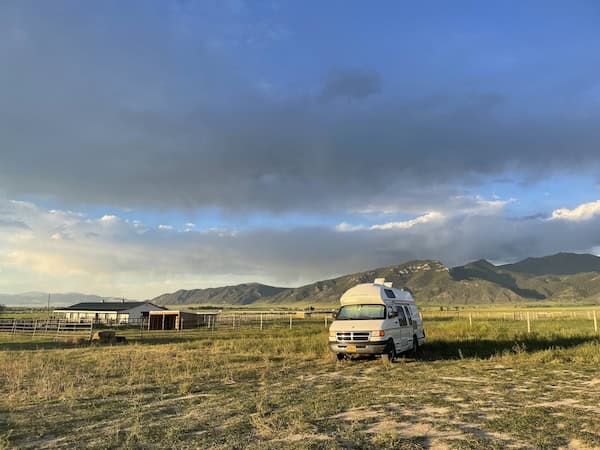
What I Love about Harvest Hosts
What I don’t Love about Harvest Hosts
3. iOverlander Camping and RV app
IOverlander is a free crowd-sourced app that is super useful for finding camping spots, dump stations, water, informal camp sites and free national forest and BLM camping and overnight spots.
Whether you’re looking for a Walmart to overnight in, secluded forested spots, roadside pull-offs or established public and private campgrounds, iOverlander has you covered. I use iOverlander as a first stop information spot.
I read the reviews to see that others have said about the site and if it feels like it will be a safe spot for me. I also read about access because my 25 year old RV does not like bumpy steep gravel climbs and some of the places do suggest 4 wheel drive. If I determine a site looks suitable, I then try to verify the location on another app if possible.
Because it is crowd-sourced, the information is sometimes not accurate. It only took one time of following incorrect GPS coordinates down a washed out road to quickly realize I could not soley rely on iOverlander. One thing I do love about the app is this message that appears when a site has not been verified “iOverlander cannot verify if wild camping is permitted at this location. It is your responsibility to verify local laws or obtain consent before staying the night.” If I see that message and only one review, I usually move on. But if many people report staying there, then I assume it’s valid and check it out.
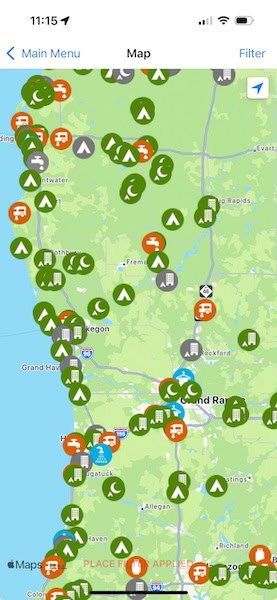
What I Love About iOverlander
What I don’t Love about iOverlander
4. Campendium
Campendium is another free app that lists established and informal camping areas. I find the reviews written by fellow campers to be super helpful when deciding where to stay. The thing I appreciate the most about Campendium is the reports on cell signal. As a solo women traveling, and because I often need to work on the road, I like to stay in places where I know I will have good cell signal. Campendium lists how many bars of cell service you can receive for Verizon, AT&T and T-Mobile.
They also list what amenities are available—like water, dump station, electric hook-ups and if tents are OK. Reviews often mention what there is to do in the area. As a solo traveler, it’s good to have all this information in one app. They also have a direct link to GPS coordinates that you can open in Apple maps, Google maps or simply copy the GPS coordinates. Campendium has become the app I’ve come to use the most for finding established camping sites.
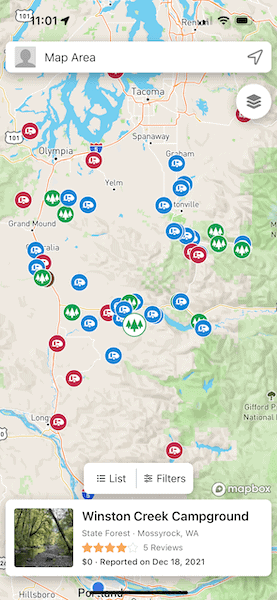
What I Love about Campendium
What I Don’t Love about Campendium
5. Recreation.gov Camping App
While I don’t use this app on a daily basis, it does serve a purpose. When I stay in campgrounds, I prefer national forest, national parks, state parks and Bureau of Land management because they’re often in the woods or wild areas that I want to be in anyway. This app is essential for making reservations at those public camping areas and a great place to keep all your reservations handy when it comes time to check in.
It’s not the best search tool, however, as it only shows the public campgrounds. For example, when I search in Yuma, AZ in the app, it shows me spots in Joshua Tree National Park, more than 100 miles away.
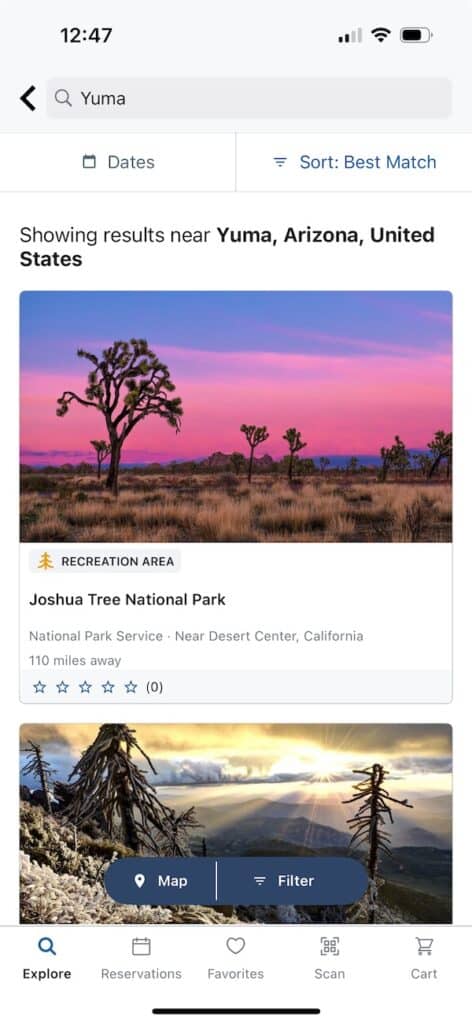
What I love about Recreation.gov
What I don’t love about Recreation.gov
6. HipCamp
There are a lot of people who have beautiful pieces of private property and spots for RVs to park and lots of RVers looking for an alternative place to stay. That’s where Hipcamp comes in. HipCamp gives RVers access to private land owners who rent out their property for camping.
I don’t use HipCamp a lot, but I do think it’s a great tool to have in my arsenal when needed.
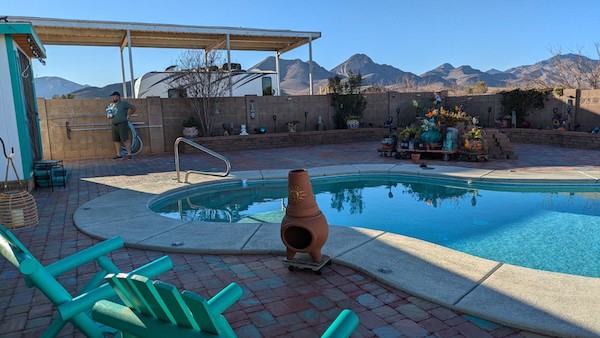
What I love about HipCamp
What I don’t love about HipCamp
7. All Trails
All Trails is wonderful for finding good hiking and biking trails nearby. You can either use your current location or enter a city or park and plan your hiking ahead of time. The free version has lots of great features such as searching for trails and filtering by things such as dog-friendly or hiking/biking. The paid version allows you to follow along your hiking route, even if you don’t have cell signal. This can be invaluable for solo hikers worried about getting lost. (Like me!)
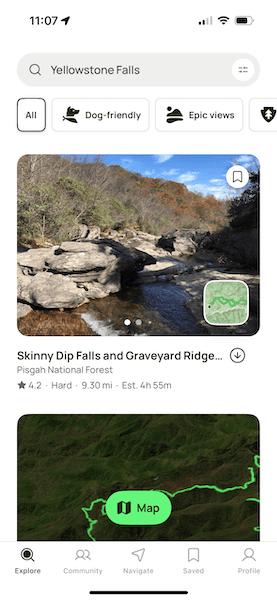
What I love about All Trails
What I don’t love about All Trails
8. GasBuddy
With gas prices so high right now, this is an app I’ve used more this year than ever before. Gas Buddy shows you in real time the gas prices of stations in your area. I was surprised to find that sometimes the bigger towns don’t necessarily have the best gas prices. Saving $.20 gallon adds up when you only get 10-12 MPG.
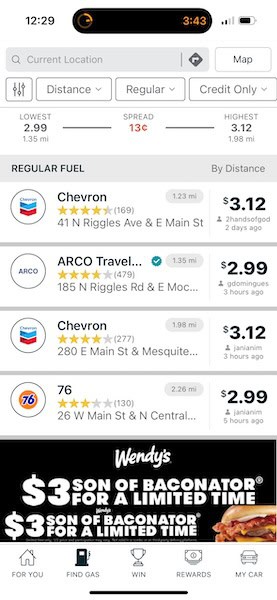
What I love about Gas Buddy
What I don’t love about Gas Buddy
9. Google Maps
Maybe this is a no-brainer. Most of us likely use Google Maps so often, we don’t even think of it as an RV app. I use Google maps to research and plan trips and use it as a second source for step by step navigation.
One of my favorite features of Google is that I can bookmark spots that I want to check out in the future. If someone tells me about a great camping spot or I read about a really cool boondocking site online, I can save it as “Want to go” or “favorite.”
I also love that the Google maps app allows me to follow my friends and fellow nomads in real time by sharing our location. I also share my location with trusted friends and family members, so they can keep an eye on me from afar.
I usually prefer my RV GPS for step by step navigation because I can enter in the dimensions of my RV and the screen size is bigger and easier to follow, but Google maps is a good back-up.
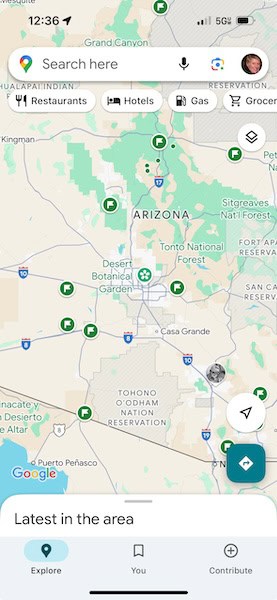
What I love about Google Maps
What I don’t love about Google Maps
10. Altimeter
Altimeter is a fun app that I use to see what elevation I’m at. It also shows your GPS coordinates and has a compass feature. I’m always curious what elevation I’m at, so I check this app pretty regularly. That’s it. It’s pretty simple. And totally free.
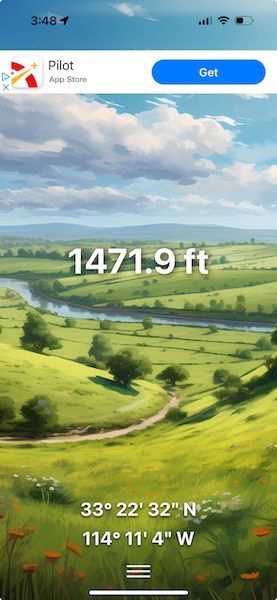
What I love about Altimeter
What I don’t love about Altimeter
11. Wind Alert App
As nomads, we need to keep a close eye on the weather. Driving in the wind and ice can be dangerous. Freezing temps can destroy our water lines. There are a lot of different weather apps out there and I have a few different ones. While I check the weather app on my iPhone regularly, when I need to know what the wind conditions are going to be, I depend on the Wind Alert App.
I like it because it shows wind speed and direction and you can look ahead and see what the wind forecast is going to be. You can also set up alerts to get notifications based on criteria you set up. And it’s free!
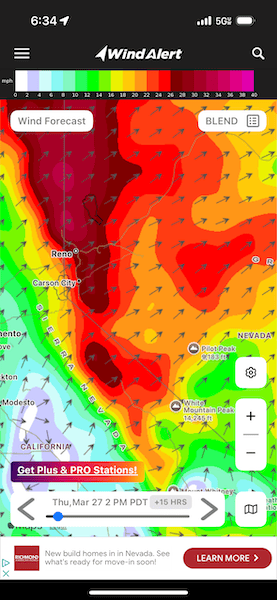
What I love about Wind Alert App
What I don’t love about Storm Radar
Conclusion: My Favorite Camping Apps
There you have it, these are my most-used camping apps for 2025. Each of them serves a bit of a different purpose or complements another app. These are great camping apps for women RVers, campers and vanlifers.

